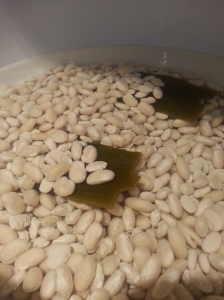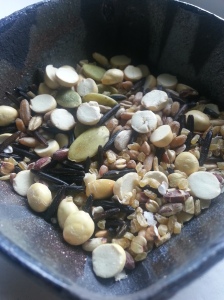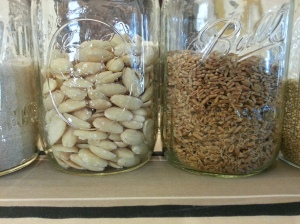Now that I have your attention, I want to talk a little bit about how to properly prepare grains, legumes, seeds, and nuts for optimal digestion. Properly prepare? What the heck does that mean? Properly or, traditionally prepared foods are foods that have been treated in a way to maximize their nutritional availability and digestibility. Grains, legumes, nuts, and seeds contain a toxic compound that not only makes them hard for us to digest but also binds to minerals rendering them useless and unavailable to our bodies. This compound is phytic acid, an anti-nutrient and general malcontent, a selfish little compound that does not want to share the healthy magnesium, calcium, iron, or zinc that is present in the foods we consume. Not only are these minerals from the grains, legumes, nuts, or seeds not bio-available but also from the other foods we are consuming along side. The other problem with these foods are the short-chain carbohydrates, also known as sugar, that are hard for our bodies to digest and tend to stick around in our guts and ferment. As opposed to good fermenting, in jars, outside our bodies, growing good bacteria, this fermenting in your intestines causes gas, bloating, and inflammation.
I am sure at this point you probably are thinking “Why in the world would I continue to eat these foods if they do all that to my body?” Well, there are many camps that agree and won't touch the stuff. Paleo and Primal ways of eating do not include grains and legumes and do not see the point of eating food that is so disruptive to the digestive system. Here is a good description of Paleo by Diane Sanfilippo over at www.balancedbites.com. I follow a different theory of healthy ways to eat. As opposed to Paleo, my diet includes Properly Prepared grains, legumes, nuts, and seeds. This follows the Weston A. Price Foundation, or WAPF way of eating. You can learn more about that here, www.westonaprice.org.
Properly preparing foods cuts down on the level of phytic acid present and performs a sort of “pre-digestion” if you will, making these foods much easier on your digestive system and allowing the minerals to be more bio-available. There are 3 methods of proper preparation: Soaking, Sprouting, and Fermenting.
Soaking and Fermenting: Essentially Soaking leads to Fermenting however a short 24-48 hr soak does not necessarily mean your food is fermented, the process has only just begun. Typically a good soak is all you need for proper digestion of legumes and grains. You want to combine filtered, un-chlorinated water in a ration of 2:1 of your legumes or grain. Some believe that heating the water is necessary but I think that making sure you allow for a good long soak is all that is needed.

Give your legumes (or grains) a good rinse then place in a large bowl and cover with filtered water. Allow to soak for 24-48 hours. After soaking, rinse again, discarding the soaking liquid, and cook as you normally would. It is also believed that the addition of an acid such as lemon juice or raw apple cider vinegar with further break down the phytic acid, as well as the addition of a piece of Kombu, an edible kelp. You will want to add a tablespoon of the acid or two 2 inch pieces of kombu. You can change the water a few times over the two days if you are soaking but do not if you are fermenting.
Fermenting will lead to the growth of beneficial bacteria and fall into the realm of sourdough, Indian snacks such as dosa and idli, and soured porridge. This is a whole other post all together as there is a lot to cover on the topic of fermented grains and legumes.
Sprouting: Sprouting is the initiation of the lifecycle of the seed. Grains, legumes, seeds, and nuts are all seed of a plant therefore, once soaked they begin the process of growing into a plant. This process diminishes the phytic acid and anti-nutrients making them much more healthful. Sprouting is very simple to do:
Place 1 cup of grain, legume, nut, or seed into a quart size mason jar. Cover with 2 cups filtered water. Allow to soak over night in a warm spot. The next day, pour out the water and rinse well. Cover the opening of the jar with a bit of cheese cloth and let sit overnight again. Rinse and repeat a few times a day until you see little sprouts shooting out. Your sprouts are ready once they are approximately the length of the seed.
From here you can dry them for cooking later or grinding into flour. You can also eat them raw in salads or on sandwiches. The sprouts can be dried in the oven at 150° for anywhere from 10-24 hrs. Allow too cool and store up to 6 months. I always have mason jars full of sprouted and dried grains and legumes in my pantry so that I don't have to prepare 4 days in advance if I want sprouted quinoa for dinner on Wednesday.
A few recipes for your hard work. Sit back and reap the benefits of Properly Prepared Foods!!!
Essene Bread from the Sprout People
Sprouted Lentil Recipes from Gnowfglins.com
Creamy Grits, Two Ways
Soak your grits for a few days before cooking to yield a creamier consistency. Cook them as you would normally and enjoy with a pinch of salt and butter. Then with the leftovers, stir in a chopped garlic clove and some cheddar and pour into a casserole or bread pan. Chill in the refrigerator then slice and fry in butter for a tasty second round.
Crispy Nuts
Combine 4 cups nuts with 1 tablespoon of sea salt and cover with filtered water. Allow to sit in a warm spot over night. Drain and spread on a baking sheet and dry in the oven at 150° for 12-24 hours. Store in an airtight container for up to 3-4 months.


No comments:
Post a Comment